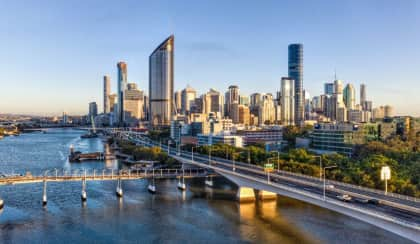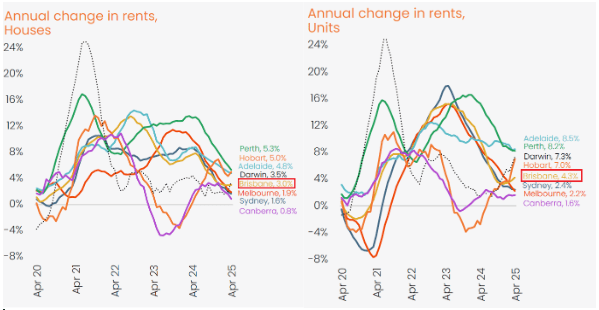Brisbane property market update
April was a subdued month for the Brisbane property market, as activity took a backseat to a series of lifestyle and political events, writes Melinda Jennison, president of REBAA and managing director of Streamline Property Buyers.

Queenslanders enjoyed an unprecedented run of three consecutive long weekends – including Easter, Anzac Day and Labour Day – which, combined with a two-week school holiday period and the federal election campaign, saw many buyers and sellers place their property decisions on hold. With more pressing personal and national matters to attend to, market momentum eased.
Despite the distractions, the Brisbane market demonstrated its continued upward price growth. Dwelling values rose 0.4 per cent in April, a consistent result with March’s performance. This upward trend reflects the city’s strong underlying fundamentals, where both owner-occupiers and investors continue to seek value in a tightening property landscape.
Compared with other capitals, Brisbane outperformed Sydney and Melbourne, which each saw only 0.2 per cent growth in April. Adelaide and Perth also delivered solid results at 0.3 per cent and 0.4 per cent respectively, while Darwin led the month with a 1.1 per cent increase. Over the past 12 months, Brisbane values are up 7.8 per cent, second only to Perth (10 per cent) and Adelaide (9.8 per cent), and far outpacing Melbourne (-2.2 per cent) and Canberra (-0.6 per cent).
Interestingly, while house values across Australia’s capitals generally outpaced unit values, Brisbane bucked the trend. Here, units recorded stronger growth than houses both over the month (0.5 per cent v 0.4 per cent) and the quarter (1.6 per cent v 0.9 per cent). This divergence highlights the unique dynamic within Brisbane’s market, where affordability pressures and limited supply are fuelling renewed demand for well-located attached dwellings.
On the taxation front, new data from the ABS revealed that property continues to shoulder a growing share of government revenue. Across Australia, state and local governments collected $45.2 billion in property-related taxes during the 2023–24 financial year. This is up 12.5 per cent year-on-year.
Stamp duty alone generated $30.8 billion, an 8 per cent rise. For buyers, these figures translate into increased transaction costs, and in Brisbane, the cost burden is particularly stark. According to a recent Sydney Morning Herald analysis, Brisbane ranks as the sixth most expensive city for stamp duty on an average home, with Hobart and Darwin the only two cities with lower stamp duty rates based on a typical house. This is perhaps one reason why more investors are seeking their positions in Brisbane as entry costs are comparatively lower compared to many other cities across the country.
External forces are also shaping buyer sentiment. The introduction of 10 per cent tariffs by the US, alongside a more aggressive tariff regime targeting China, has introduced renewed uncertainty into the global economic outlook. Although Australia’s direct exposure to US tariffs is minimal, with just 4 per cent of exports destined for America, the indirect impacts could be substantial. Trade tensions and slowing Chinese growth could weigh on business confidence and hiring. A weaker labour market would likely dampen consumer sentiment and delay property-related decisions.
However, the flip side is that such uncertainty could drive further rate cuts. With the Reserve Bank of Australia already trimming rates in February and another cut expected in May, borrowing costs are likely to fall again, a move that could further stimulate buyer demand and bolster home prices. Investors may also turn to property as a stable store of value amid volatile global markets, particularly if listing volumes remain tight.
Brisbane dwelling values
April saw Brisbane’s median dwelling value rise to $907,864, reflecting a 0.4 per cent increase for the month and 1 per cent for the quarter. This steady performance matches March’s result and continues the city’s long-term growth trend, with dwelling values now 71.1 per cent higher than five years ago and 91.2 per cent over the past decade.
Source: Cotality (formerly CoreLogic)
Compared to other capital cities, Brisbane is among the few to have surpassed its previous peak, alongside Adelaide and Perth. Melbourne, Sydney, Hobart, Darwin, and Canberra all remain below their record highs.
PropTrack reported slightly more subdued growth for Brisbane in April, with just 0.19 per cent added to dwelling values – a marginal slowdown compared to March. This divergence underscores the importance of understanding different data methodologies but doesn’t change the underlying upward trajectory.
From a segmentation perspective, the lower end of the Brisbane market continues to outperform. While the lower quartile of dwellings rose by 2.1 per cent over the quarter, the top quartile posted just 0.1 per cent growth. This affordability-driven trend suggests first home buyers and investors are actively pursuing value opportunities, particularly in the unit market.
Source: Cotality (formerly CoreLogic)
Brisbane house values
Brisbane’s median house value rose to $989,818 in April, up 0.4 per cent for the month and 0.9 per cent for the quarter. This is a 6.8 per cent increase over the past year, slightly down from the 7.5 per cent annual growth recorded in March.
Source: Cotality (formerly CoreLogic)
Cotality’s (formerly CoreLogic) figures highlight that house value growth in Brisbane has reaccelerated after some slowing earlier in the year. PropTrack also reported an increase in house values, albeit at a slightly lower rate of 0.21 per cent.
Nationally, house values across the capitals have risen by 1.1 per cent over the past three months, largely driven by premium markets in Sydney and Hobart. But Brisbane’s more balanced performance across housing types signals broader appeal, particularly in mid-priced suburbs.
Brisbane unit values
Brisbane’s unit market continued to shine in April, with median values rising 0.5 per cent to $698,479. Quarterly growth came in at 1.6 per cent, and annual growth remains strong at 12.8 per cent, down slightly from 14.1 per cent last month. PropTrack also recorded a modest 0.11 per cent increase for the month, in line with the broader slowing trend.
Source: Cotality (formerly CoreLogic)
The continued strength in unit values reflects the affordability challenge many buyers face when trying to enter the housing market. With house prices nearing $1 million, units are becoming the only viable entry point for many – especially those looking to stay within 10 kilometres of the CBD. Increased investor interest, a tight rental market, and limited new supply are all contributing to sustained demand in this segment.
Brisbane’s rental market
Brisbane’s rental market remains highly constrained. Vacancy rates fell further to 0.9 per cent in March, down from 1 per cent in February. Rental yields have held steady at 3.5 per cent for houses and climbed slightly to 4.6 per cent for units.
Annual rent growth for houses edged up to 3 per cent. Unit rents, however, rose by 4.3 per cent year-on-year, a sharp uptick from 3.9 per cent in March, indicating reaccelerating demand in the more affordable rental segments.

Source: Cotality (formerly CoreLogic)
With stock levels tight and affordability stretched, Brisbane’s rental market is expected to remain competitive, further supporting investor interest across the city.
Summary
April may have seen softer activity due to public holidays and political distractions, but the Brisbane property market remains in strong shape. Dwelling values are rising consistently, led by growth in the more affordable unit segment. Rental conditions are tightening, and buyer competition remains elevated, especially for well-located properties across the city.
The federal election’s impact on property sentiment remains to be seen. Both major parties are favouring demand-side housing policies, which could place additional pressure on an already undersupplied market, especially for first home buyers. With another interest rate cut anticipated in May and continued population growth, the conditions are in place for ongoing, moderate price appreciation across the remainder of 2025.
While global uncertainty, particularly relating to US-China trade tensions, may weigh on confidence, most Australian households remain financially resilient. Brisbane’s unique combination of affordability, lifestyle appeal, and strong fundamentals ensures it remains a market to watch.